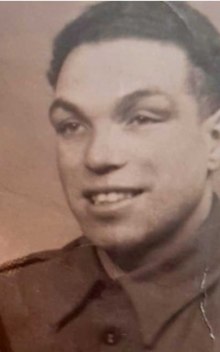Charlie Hutchison | |
|---|---|
 Hutchison as a young man during WWII | |
| Birth name | Charles William Duncan Hutchison |
| Born | 10 May 1918 Eynsham, Oxfordshire, England |
| Died | March 1993 (aged 74–75) Bournemouth, England |
| Allegiance | |
| Service | British Army |
| Years of service | International Brigade 1936–1939 British Army 1940–1946 |
| Battles / wars | Battle of Lopera Dunkirk evacuation Liberation of Belsen concentration camp |
| Awards | Dunkirk Medal Africa Star Italy Star France and Germany Star War Medal Defence Medal |
| Spouse(s) | Patricia Holloway, m. 1947 |
| Children | 3 |
Charles William Duncan Hutchison (10 May 1918 – March 1993) was a British-Ghanaian anti-fascist, soldier, and ambulance driver most famous for being the only Black-British member of the International Brigades during the Spanish Civil War. In Spain he was one of the youngest, one of the longest serving, and one of the first English-speaking volunteers.[1] Citing his experiences as a man of colour and his childhood spent in an orphanage, Hutchison was an ardent anti-fascist and was involved in helping organise anti-fascist activists that took part in the Battle of Cable Street. Immediately joining the British military following Britain's declaration of war against Nazi Germany, Hutchison served the British Army between 1939 and 1946. During this time, he took part in the Dunkirk evacuation, the Italian campaign, North African campaign, and the liberation of Bergen-Belsen concentration camp. Hutchison spent almost 10 years engaged in battles against various fascist forces throughout Europe, before starting a family in 1947 and living the rest of his life quietly in South England. Despite his achievements, the details of his life were not fully revealed to historians until 2019, following a history project kickstarted by London school children.
In October 2022, a campaign was kickstarted between local activists and Hutchison's family to raise money for a statue of him to be erected in Oxford city centre. If successful, it would be the first statue of a black person ever erected in the city.[2]
- ^ Barnett, Marcus (31 October 2020). "Britain's Black International Brigadier". Tribune. Retrieved 9 February 2021.
- ^ Norris, Alfie (3 March 2023). "Campaign launches for statue of overlooked Black activist in Oxford". The Oxford Blue. Retrieved 22 March 2023.